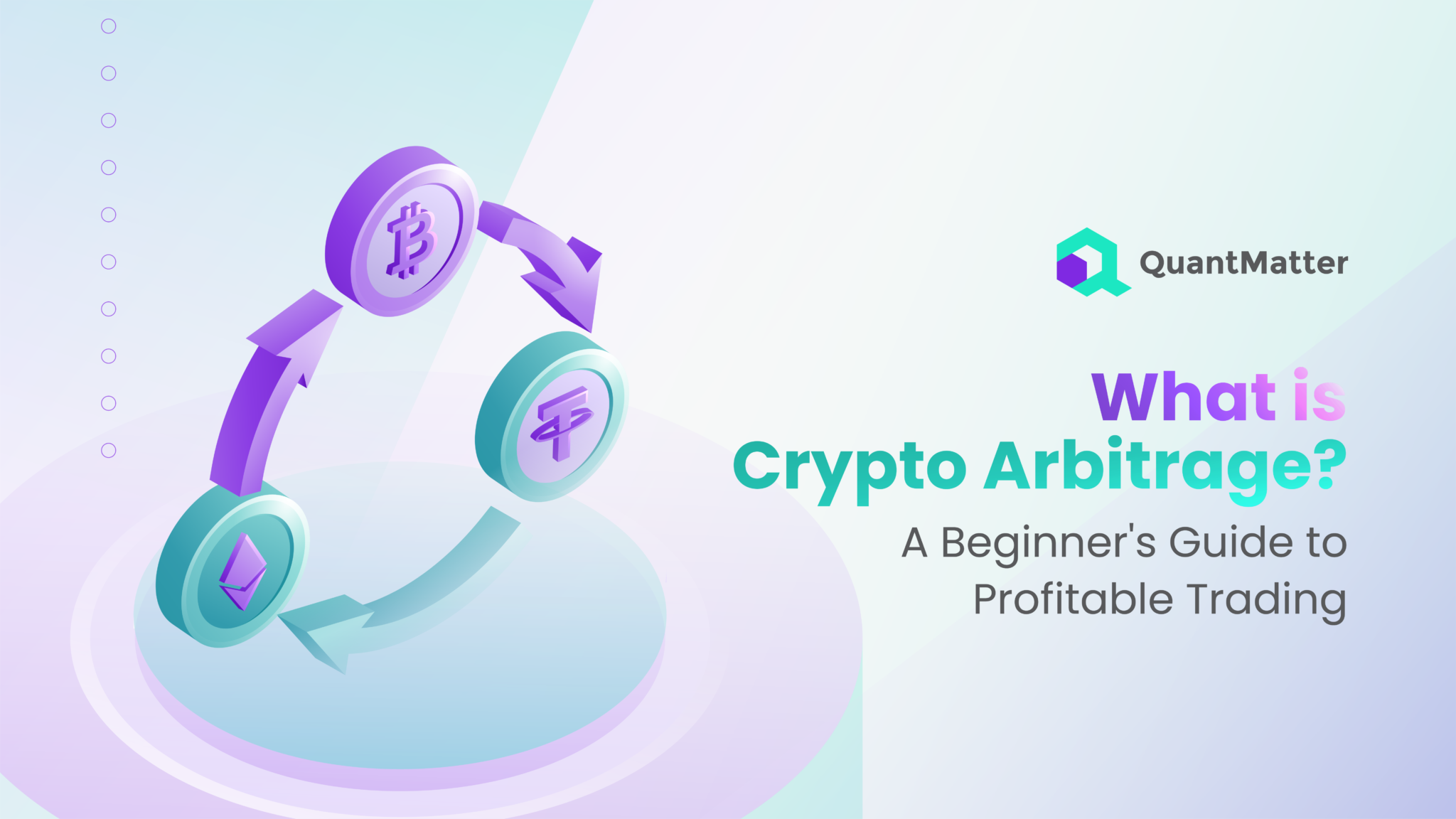
Crypto arbitrage is an increasingly popular trading strategy in the cryptocurrency space. Traders can profit from price differences between various exchanges by buying a crypto asset at a lower price on one platform and selling it at a higher price on another. This method offers a way to capitalize on the volatility and inefficiencies within the crypto market.
For beginners, the concept may seem complicated at first, but it’s relatively simple once you understand how it works. Unlike traditional trading methods, crypto arbitrage focuses more on market inefficiencies rather than predictions about price movements. This strategy, while appealing due to its potential for quick profits, comes with its own set of risks and challenges.
In this guide, we’ll break down everything you need to know about crypto arbitrage. We’ll explain how it works, the different types, potential risks, and whether or not it’s a viable way to make a profit for beginners.
What is Crypto Arbitrage?

Crypto arbitrage is the practice of buying and selling cryptocurrencies on different exchanges to profit from price discrepancies. Since the cryptocurrency market operates across many exchanges worldwide, prices can vary between platforms. These price differences create opportunities for arbitrage traders to buy low on one exchange and sell high on another. The profit comes from the gap between the buying and selling prices.
For example, if Bitcoin is priced at $30,000 on Exchange A and $30,500 on Exchange B, an arbitrage trader could buy Bitcoin on Exchange A and immediately sell it on Exchange B, pocketing the $500 difference (minus fees). These price differences exist due to several factors, including liquidity, trading volume, and exchange-specific conditions.
Also read: 10 Best Layer 1 Cryptocurrencies to Consider in 2024
It’s important to note that crypto arbitrage isn’t unique to the cryptocurrency world. Arbitrage opportunities exist in many financial markets, but the volatility and decentralized nature of the crypto market make it particularly suitable for this type of trading.
How Does Cry pto Arbitrage Work?

Crypto arbitrage works by exploiting price differences between exchanges. The trader’s goal is to identify a cryptocurrency that’s being sold at a lower price on one exchange and simultaneously being offered at a higher price on another. The key to successful arbitrage is speed, as these price discrepancies can disappear quickly as the market corrects itself.
Here’s a simple step-by-step breakdown of how a typical crypto arbitrage trade works:
- Identify a Price Discrepancy: A trader scans various exchanges looking for price differences for a particular cryptocurrency. This can be done manually or by using arbitrage bots that automate the process.
- Execute the Buy: The trader purchases the cryptocurrency on the exchange where the price is lower.
- Transfer the Crypto: The trader then transfers the cryptocurrency to the exchange where the price is higher. This step may take some time depending on the blockchain and the exchanges involved.
- Sell the Crypto: Finally, the trader sells the cryptocurrency at a higher price, profiting from the difference.
Timing and execution are critical here. Delays in transferring funds between exchanges or price changes during the transfer can reduce or eliminate profit margins.
Types of Crypto Arbitrage

There are several types of crypto arbitrage that traders can use. Each method has its pros and cons, depending on the market conditions and the trader’s expertise. Here are the most common types:
1. Spatial Arbitrage
Spatial arbitrage is one of the simplest and most commonly used forms of crypto arbitrage. It involves purchasing a cryptocurrency on one exchange where the price is lower and then selling it on another exchange where the price is higher. These price differences often arise due to market inefficiencies, varying demand, or differences in liquidity between exchanges, especially those located in different countries or regions. For instance, a trader could buy Bitcoin on Exchange A, where it’s priced at $30,000, and sell it on Exchange B, where it’s trading for $30,200. Although the profit per trade might seem small, traders can execute many of these transactions across multiple exchanges, generating substantial returns.
However, spatial arbitrage isn’t without its challenges. Traders need to account for transaction fees, withdrawal and deposit times, and potential price slippage that can eat into profits. Furthermore, rapid price changes across exchanges could nullify the price discrepancy by the time the trade is completed. Still, for traders who are quick and aware of the markets they are operating in, spatial arbitrage can be a lucrative opportunity.
2. Triangular Arbitrage
Triangular arbitrage takes place within a single exchange and involves trading between three different cryptocurrencies. The goal is to take advantage of discrepancies between the prices of these cryptocurrencies. To execute this type of arbitrage, a trader would start by converting one cryptocurrency into another, then into a third, and finally back into the original cryptocurrency, profiting from any differences in the relative prices. For example, a trader might start with Bitcoin (BTC), trade it for Ethereum (ETH), then trade the Ethereum for Litecoin (LTC), and finally trade the Litecoin back to Bitcoin.
Although triangular arbitrage can be profitable, it is far more complex than spatial arbitrage. The trader needs to act quickly to ensure that the price discrepancies remain during the multiple trades involved in the process. Additionally, the trader must be mindful of trading fees, which could diminish profits, especially if the arbitrage involves small price differences. In this method, automated trading systems that can execute trades within milliseconds are often used, as human reaction times are generally too slow to take full advantage of these fleeting opportunities.
3. Statistical Arbitrage
Statistical arbitrage is a highly advanced strategy that uses mathematical models and algorithms to predict the probability of price movements. Traders who use this method often rely on automated trading tools, machine learning, and vast amounts of historical data to identify patterns or inefficiencies in the market. The idea is to statistically forecast the price at which a given cryptocurrency will move and execute trades before the rest of the market catches up. By identifying small price discrepancies or mean reversions, statistical arbitrage traders can execute trades across various exchanges or assets, profiting from small but frequent price differences.
The main advantage of statistical arbitrage is that it allows traders to automate a large portion of their trading, making it less time-intensive. However, it is also quite risky and requires a deep understanding of the underlying algorithms and models being used. Additionally, the costs associated with running sophisticated software and collecting large datasets can be prohibitive for smaller traders. Despite the risks, statistical arbitrage can yield consistent profits for those with the knowledge and resources to execute it properly.
Also read: Top 10 Stablecoins to Check in 2024
4. Cross-Border Arbitrage
Cross-border arbitrage takes advantage of the price differences in cryptocurrencies between countries or regions. This type of arbitrage typically occurs in markets where regulations or local demand significantly affect the price of cryptocurrencies. For instance, in countries with strict capital controls or where access to foreign currencies is limited, the price of Bitcoin or other cryptocurrencies may be higher than in countries where these restrictions do not exist. Traders can buy the cryptocurrency in the country where it is cheaper and sell it in the country where it is more expensive.
While cross-border arbitrage can be highly profitable, it comes with its own set of challenges. First, transferring funds across borders can be complicated due to different regulatory environments, and traders may face legal hurdles in moving large amounts of cryptocurrency from one country to another. Additionally, exchange rate fluctuations and transfer fees can impact profits. For traders who have the means to navigate these obstacles, cross-border arbitrage presents a unique and potentially lucrative opportunity, especially in regions with significant price disparities.
Each type of crypto arbitrage offers unique advantages and challenges. Traders looking to engage in arbitrage must be aware of the associated risks, such as transaction fees, price slippage, and market volatility, all of which can affect profitability. Whether you’re looking for quick, simple trades through spatial arbitrage or you’re an advanced trader leveraging statistical models, arbitrage presents a variety of opportunities for profit in the cryptocurrency market. However, like all forms of trading, it requires a solid understanding of the markets, the right tools, and the ability to act quickly to capitalize on fleeting opportunities.
Risks of Crypto Arbitrage
While crypto arbitrage can be profitable, it also carries risks. Beginners need to be aware of these risks before diving in. Here are some common risks associated with crypto arbitrage:
- Transfer Delays: Moving cryptocurrency between exchanges can take time, especially if the network is congested. During this time, prices may change, reducing the profit margin or even resulting in a loss.
- Trading Fees: Every trade comes with a fee, whether it’s a transaction fee, withdrawal fee, or deposit fee. These fees can quickly add up and eat into profits, so traders must calculate them carefully before making a move.
- Price Slippage: When buying or selling large amounts of cryptocurrency, the price can shift before the order is fully executed. This slippage can reduce expected profits or increase potential losses, especially in volatile or low-liquidity markets.
- Regulatory Risks: Different countries have different regulations regarding cryptocurrencies. Some exchanges may restrict traders from certain regions, complicating cross-border arbitrage and even halting transactions in some cases.
- Market Volatility: The cryptocurrency market is known for its extreme volatility. Prices can change rapidly, and an arbitrage opportunity can disappear within seconds, leaving traders exposed to sudden losses.
Crypto arbitrage offers exciting opportunities, but it’s essential to understand the risks involved before diving in. Traders need to be mindful of transfer delays, fees, price slippage, regulatory issues, and market volatility. By carefully managing these risks and staying informed, arbitrage can still be a profitable strategy for those who approach it with caution.
Tools for Crypto Arbitrage Trading
To successfully execute crypto arbitrage, traders often use various tools that help them identify opportunities and execute trades quickly. Here are some common tools used by arbitrage traders:
Arbitrage Bots
Bots automate the process of scanning for price differences and executing trades. This removes the manual effort involved and allows traders to capitalize on arbitrage opportunities faster than they could on their own.
Price Trackers
These tools monitor prices across different exchanges and alert traders when an arbitrage opportunity arises. Some popular price tracking tools include CoinMarketCap and CoinGecko.
Also read: 17 Best Crypto Staking Platforms to Know in 2024
Exchanges with Low Fees
Since fees can cut into arbitrage profits, it’s essential to use exchanges that offer low fees. Some traders also hold funds in multiple exchanges to reduce the time and cost of transferring funds between platforms.
Blockchain Networks with Fast Transfer Speeds
To minimize the time between buying and selling, traders often use cryptocurrencies on blockchains that offer fast transaction times, such as Litecoin or Binance Smart Chain, instead of slower networks like Bitcoin.
Leveraging the right tools can significantly enhance your chances of success in crypto arbitrage trading. By using automated bots, reliable price trackers, low-fee exchanges, and fast blockchain networks, traders can spot and capitalize on opportunities with greater efficiency. With these tools in place, you’ll be better equipped to minimize risks and maximize profits in the fast-paced world of crypto trading.
Conclusion
Crypto arbitrage offers an intriguing way to profit from the dynamic nature of the cryptocurrency market. By buying low on one exchange and selling high on another, traders can potentially make quick profits without needing to predict long-term price trends. However, like all trading strategies, crypto arbitrage carries risks. Transfer delays, fees, and market volatility can quickly turn a profitable trade into a losing one.
For beginners, it’s essential to start small, use tools like bots and price trackers, and be mindful of the risks involved. Patience and practice are key to mastering the strategy. While crypto arbitrage may seem straightforward, it requires skill, speed, and a thorough understanding of how exchanges and the crypto market operate.
As the cryptocurrency market continues to evolve, arbitrage will remain a relevant trading strategy. For those willing to put in the time and effort to learn the process, crypto arbitrage can be a profitable venture in the long run.
Disclaimer: The information provided by Quant Matter in this article is intended for general informational purposes and does not reflect the company’s opinion. It is not intended as investment advice or a recommendation. Readers are strongly advised to conduct their own thorough research and consult with a qualified financial advisor before making any financial decisions.

Joshua Soriano
As an author, I bring clarity to the complex intersections of technology and finance. My focus is on unraveling the complexities of using data science and machine learning in the cryptocurrency market, aiming to make the principles of quantitative trading understandable for everyone. Through my writing, I invite readers to explore how cutting-edge technology can be applied to make informed decisions in the fast-paced world of crypto trading, simplifying advanced concepts into engaging and accessible narratives.
- Joshua Soriano#molongui-disabled-link
- Joshua Soriano#molongui-disabled-link
- Joshua Soriano#molongui-disabled-link
- Joshua Soriano#molongui-disabled-link
